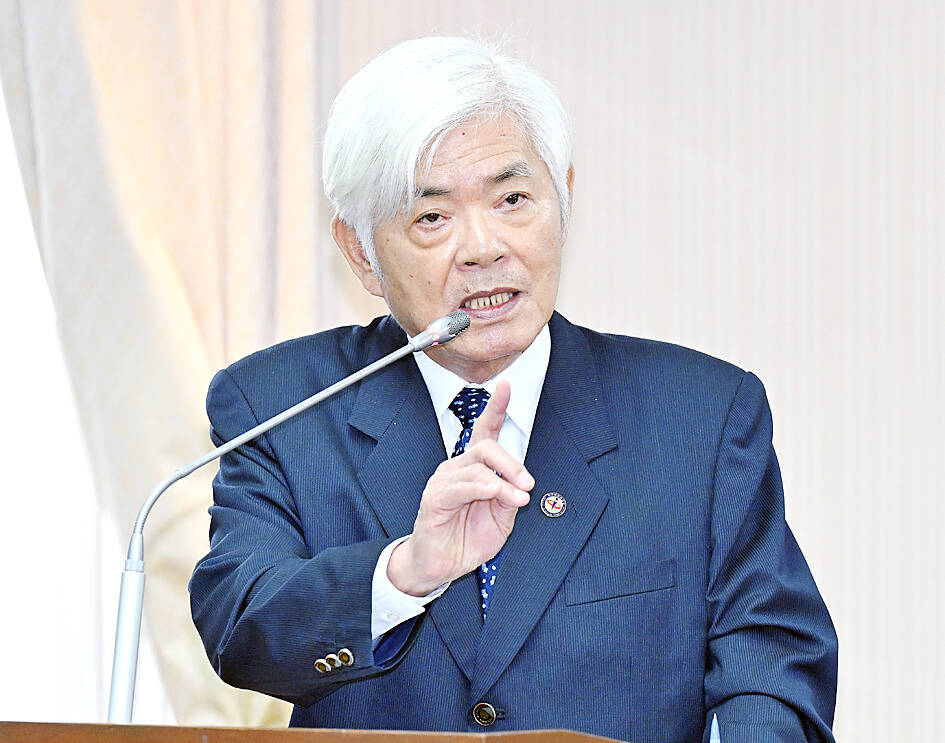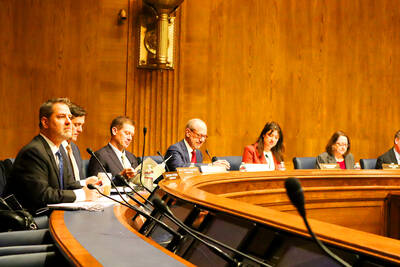Two proposed national referendum questions could be bundled with recall votes against legislators in one election, depending on whether certain conditions are met, Central Election Commission (CEC) Chairman Lee Chin-yung (李進勇) said yesterday.
At a meeting of the legislature’s Internal Administration Committee, Chinese Nationalist Party (KMT) legislators asked Lee if the referendums could be combined with recall votes to save costs.
Lee said that it could be done, but the process must conform to the law, reduce expenditures and resources, and would depend on the amount of work needed from election commission personnel.

Photo: Liao Cheng-hui, Taipei Times
KMT Legislator Chang Chih-lun (張智倫) said the recalls and national referendums should be held on the same day, to reduce expenses, resources and administrative workload.
KMT lawmakers, with support from their Taiwan People’s Party colleagues, have placed the referendum proposals on the legislative agenda for a vote tomorrow.
Putting the referendums, which oppose martial law and the abolition of the death penalty, on the ballot would act as a countermeasure to recall campaigns targeting KMT legislators, the parties’ leaders have said.
The earliest recall votes could be held would be in the first weeks of July, but as circumstances and rolling timetables are different for each electorate district, the dates are subject to change, Lee said.
“If a recall petition was submitted today, and if it passes the checks and inspection procedures, it could be formally approved to enter into third stage somewhere in mid-June,” he said.
However, a grace period of 20 to 60 days before the finalization of the recall voting day could mean a vote could be held at the earliest in the first-half of July, he said.
Each electoral district has different processing times and amount of work to be compiled, and the submission dates are different, meaning inspections for fraud and errors would not be completed at the same time, and therefore recall votes might not be held on the same date, he said.
Regarding the costs of holding recall votes, Lee said that the 2021 recall against then-Taiwan Statebuilding Party legislator Chen Po-wei (陳柏惟) of Taichung cost NT$20 million (US$660,175 at the current exchange rate).
An unsuccessful 2022 recall campaign against then-independent legislator Freddy Lim (林昶佐) of Taipei, the singer of the heavy metal band Chthonic, cost about NT$15 million, he said.
“It is difficult to estimate how much a recall vote would cost, as there are numerous factors and uncertainties, including district population numbers, the constituency’s area, composition of voters and population density, and other elements,” Lee said.
The recall votes against Chen and Lee would probably cost about NT$18 million if held today, he added.
As of yesterday, recall campaigners targeting KMT legislators have submitted petitions in the second stage of the recall, which requires signatures from at least 10 percent of voters in a district.
The groups said they expect petitions to be approved for 30 out of 35 targeted constituencies nationwide.

MISINFORMATION: The generated content tends to adopt China’s official stance, such as ‘Taiwan is currently governed by the Chinese central government,’ the NSB said Five China-developed artificial intelligence (AI) language models exhibit cybersecurity risks and content biases, an inspection conducted by the National Security Bureau (NSB) showed. The five AI tools are: DeepSeek, Doubao (豆包), Yiyan (文心一言), Tongyi (通義千問) and Yuanbao (騰訊元寶), the bureau said, advising people to remain vigilant to protect personal data privacy and corporate business secrets. The NSB said it, in accordance with the National Intelligence Services Act (國家情報工作法), has reviewed international cybersecurity reports and intelligence, and coordinated with the Ministry of Justice Investigation Bureau and the National Police Agency’s Criminal Investigation Bureau to conduct an inspection of China-made AI language

BOOST IN CONFIDENCE: The sale sends a clear message of support for Taiwan and dispels rumors that US President Donald Trump ‘sold out’ the nation, an expert said The US government on Thursday announced a possible sale to Taiwan of fighter jet parts, which was estimated to cost about US$330 million, in a move that an expert said “sends a clear message of support for Taiwan” amid fears that Washington might be wavering in its attitude toward Taipei. It was the first announcement of an arms sale to Taiwan since US President Donald Trump returned to the White House earlier this year. The proposed package includes non-standard components, spare and repair parts, consumables and accessories, as well repair and return support for the F-16, C-130 and Indigenous Defense Fighter aircraft,

CHECKING BOUNDARIES: China wants to disrupt solidarity among democracies and test their red lines, but it is instead pushing nations to become more united, an expert said The US Department of State on Friday expressed deep concern over a Chinese public security agency’s investigation into Legislator Puma Shen (沈伯洋) for “secession.” “China’s actions threaten free speech and erode norms that have underpinned the cross-strait ‘status quo’ for decades,” a US Department of State spokesperson said. The Chongqing Municipal Public Security Bureau late last month listed Shen as “wanted” and launched an investigation into alleged “secession-related” criminal activities, including his founding of the Kuma Academy, a civil defense organization that prepares people for an invasion by China. The spokesperson said that the US was “deeply concerned” about the bureau investigating Shen

LIMITS: While China increases military pressure on Taiwan and expands its use of cognitive warfare, it is unwilling to target tech supply chains, the report said US and Taiwan military officials have warned that the Chinese People’s Liberation Army (PLA) could implement a blockade within “a matter of hours” and need only “minimal conversion time” prior to an attack on Taiwan, a report released on Tuesday by the US Senate’s China Economic and Security Review Commission said. “While there is no indication that China is planning an imminent attack, the United States and its allies and partners can no longer assume that a Taiwan contingency is a distant possibility for which they would have ample time to prepare,” it said. The commission made the comments in its annual